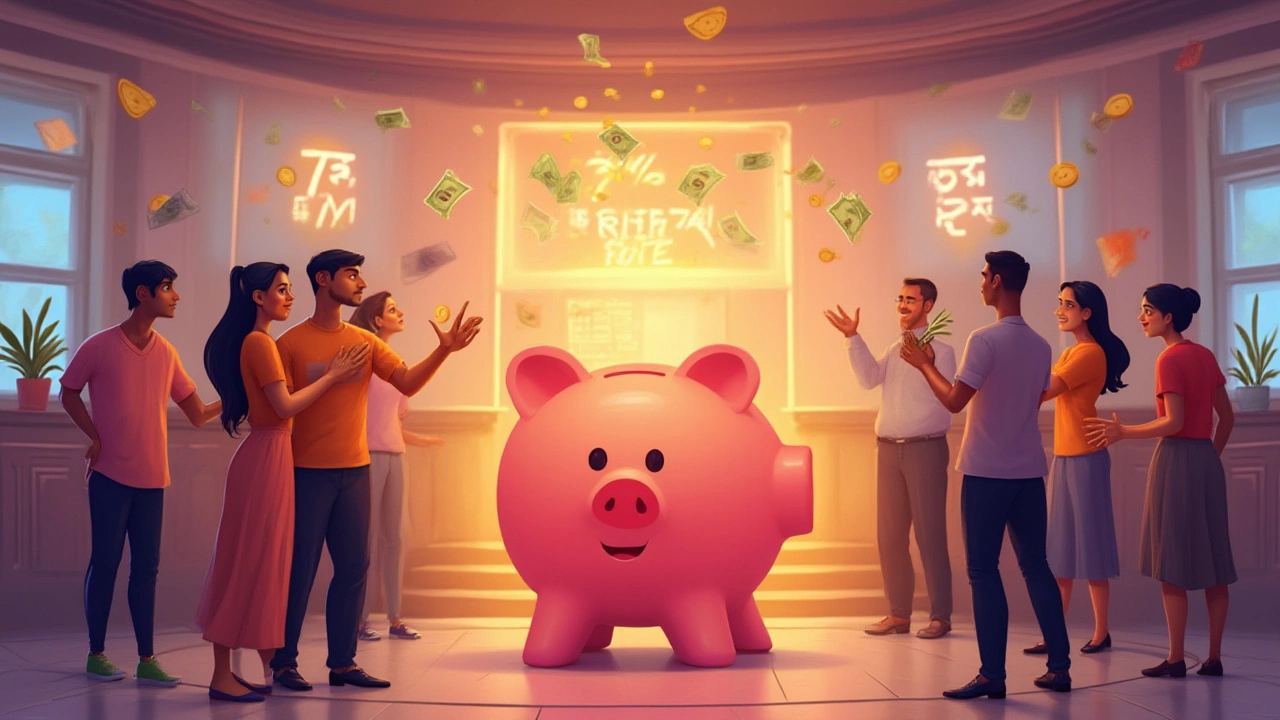It’s wild to think that not long ago, getting 4% interest on your savings account felt like winning a tiny lottery. Jump to July 2025, and now banks in India and a few global digital banks are dangling jaw-dropping 7% rates—no tiny print, no too-good-to-be-true loopholes. I remember chatting with my wife Maya over breakfast, just trying to wrap our heads around the numbers. 7% on lazy money sitting in a savings account? That’s more than a fixed deposit in some years, and for many folks, it almost sounds suspicious. But is it as good as it looks, or is there a catch? Let’s get into all the gritty details, shattered myths and find answers that actually make sense, without all the bank-speak.
Which Banks Actually Offer 7% Interest on Savings Accounts in 2025?
This year, a handful of banks in India have muscled in with real, advertised 7% interest rates on certain savings accounts, leaving traditional banks and even many aggressive digital challengers feeling a little left out. For regular folks like you and me, the big names leading the charge are:
- AU Small Finance Bank: Famous for shaking up the scene, AU Bank has consistently offered eye-catching rates the past few years. As of July 2025, its Savings Pro account tier still delivers a fixed 7% per annum interest for end-balance slabs starting at Rs 1 lakh and above.
- Equitas Small Finance Bank: This bank has matched the 7% number for specific high-threshold accounts, albeit with changing rules past certain deposit amounts.
- Jana Small Finance Bank: Their online-focused variant, especially for new accounts, holds steady at a sweet 7% annual rate on deposits exceeding Rs 50,000.
- Utkarsh Small Finance Bank: Growing quietly in smaller cities, their digital savings account option brought back the strong 7% rate this summer, targeting mobile-savvy users mostly.
But keep in mind, most of the 7% deals in July 2025 come from small finance banks. The largest public and private sector banks—think SBI, HDFC, ICICI, or Kotak—are sitting between 3% and 5%. The difference is impossible to miss.
Outside India, global neobanks like Varo Bank in the US and some digital-first UK challenger banks have toyed with headline rates near 7% for promotional periods, but their usual base is closer to 5% for actual day-to-day savings. In Singapore, GXS and a few other fintech banks play with short-run bonus rates, but you rarely get a true, long-term 7% on plain savings balances.
| Bank Name | Interest Rate (annum) | Minimum Balance to Earn 7% | Special Conditions |
|---|---|---|---|
| AU Small Finance Bank | 7% | Rs 1 Lakh | Balance above Rs 1 lakh, paid monthly |
| Equitas Small Finance Bank | 7% | Rs 5 Lakhs | Slab rate for high balances |
| Jana Small Finance Bank | 7% | Rs 50,000 | Online-only variant, T&Cs apply |
| Utkarsh Small Finance Bank | 7% | Rs 1 Lakh | Primarily on digital accounts |
All data is current as of July 17, 2025; rates are subject to periodic revision.
How Do These High-Interest Savings Accounts Work?
The big question is, why are these banks throwing around such high interest, and is your money really safe with them?
Here’s what’s going on behind the curtain: Small finance banks in India are newer players. They don’t have the giant branch networks or deep corporate customers that public banks enjoy. But to compete, these banks have to attract regular savers—like us—with bold interest rates and digital-first experiences. When you park your money here, the bank uses those funds to offer loans at higher rates (think microloans or SME business loans that can touch 13–16%). They can afford to pay out higher interest because their lending arm is earning even more from riskier, higher-margin loans.
The process works pretty cleanly: open a digital savings account, complete the simple KYC online, and fund your account. Most banks calculate interest on daily closing balances and pay it monthly or quarterly. If you cross the minimum slab (usually Rs 1 lakh or Rs 5 lakh), your extra cash above that slab earns the best rates. For example, if the first Rs 1 lakh earns 4% and the rest earns 7%, you’ll see it broken down in your statement.
But don’t get too starry-eyed—these higher rates may only last as long as the market stays hungry. Some smaller banks can revise their rates every quarter. So, you might open an account today for 7%, and next fiscal year it could slide down to 6% or lower if inflation drops or RBI policy changes. Always read the fine print.
On the safety front, all these small finance banks are regulated by RBI and are part of the DICGC insurance scheme. That means your deposits (up to Rs 5 lakh) are protected exactly like in HDFC or SBI. So unless you’re stashing crores, your primary stack is just as safe here as in any traditional megabank.
And lastly, account opening is usually a breeze—banks like AU and Jana let you set up everything via mobile app, no paperwork needed. Their apps rival the digital experience you’d expect from neo-banks in Singapore or the UK.

Pros and Cons of High-Interest Savings Accounts
Look, a 7% interest account gets attention, but there’s more to the story than just headline numbers. Here’s the real trade-off, not just as bullet points but with gritty context:
- Pro: Better returns without long lock-in. You don’t have to freeze funds for a year like an FD. The flexibility is awesome if you want instant access to your savings.
- Pro: Monthly interest calculation. Many banks credit interest monthly, so you’re effectively compounding at a higher pace.
- Pro: Great for emergency funds. If you like your just-in-case money to also work a little harder, these accounts are perfect.
- Con: Minimum balance is often high. The juiciest rates kick in above Rs 1 lakh or even Rs 5 lakh. For college students or early-career folks, that’s a big ask.
- Con: Volatile rates. Small finance banks can cut rates at the drop of a hat. Your 7% today could become 5.5% by next Diwali.
- Con: Fewer premium perks. You won’t get airport lounge access cards or high-frequency ATM withdrawals for free. These banks run lean and mean.
- Con: Branch network is limited. Most of these banks rely on digital servicing; if you want to walk into a branch in every city, you’ll miss that old-school safety net.
- Pro (surprise!): DICGC covers you up to Rs 5 lakh, like any other scheduled Indian bank.
In Maya’s case, she set up her travel emergency stash in one of these 7% savings accounts, since she wanted something liquid but productive. It’s not replacing her main account at a national bank, but the returns beat regular savings any day, as long as we’re comfortable with everything digital.
Don’t forget, interest earned above Rs 10,000 per year from all your bank savings accounts is taxable under "Income from Other Sources" and attracts TDS. Always declare that when you file taxes or you could get an unexpected notice from the tax department.
Tips To Maximize Your High-Interest Savings Returns
If you want to squeeze the best out of these 7% accounts, a little smart planning goes a long way:
- Keep your core savings there, but leave daily transactions in your traditional bank. This helps avoid penalty fees from falling below the required minimum.
- Monitor rate changes every quarter. These banks publish interest rate updates on their website—subscribe to alerts so you never get blindsided.
- Split balances if you have more than Rs 5 lakh. Remember, DICGC insurance is capped per bank, not per account. If you have lots of cash, spread it across two or more small finance banks.
- Automate a sweep out if the bank offers it. If your balance surges, some banks let you automatically route the extra to an FD or recurring deposit, locking in higher rates for a fixed period (if you prefer certainty over liquidity).
- Track tax rules closely. If you’re getting close to Rs 10,000 in annual interest income, prepare for those taxes. It might make sense to switch some savings to tax-free government bonds or post office savings if you want to avoid the tax hit.
- Read those app notifications! Small banks push their latest offers and rate changes directly on their apps, sometimes with limited-period flash deals.
And here’s a quirky tip: If you and your spouse both want to maximize insurance coverage, open individual accounts at the same small finance bank—you both get your own Rs 5 lakh coverage under DICGC. Maya figured this out and doubled our peace of mind.

Will These 7% Interest Accounts Last Beyond 2025?
The honest answer is: not forever, but you should take advantage while they’re here. Interest rate environments move fast—when inflation falls or when small finance banks get tons of new deposits, rates could slip. If the RBI cuts repo rates or big banks get competitive, that 7% could easily fall to 6% or lower. That means right now is probably peak time for parking your idle cash in these accounts—especially for short to medium savings windows.
For longer-term money, don’t rely on high-yield savings forever. Consider mixing things up—put some funds in government bonds, mutual funds, or fixed deposits to balance the risk of rate cuts. If you’re into the DIY method, check rate trends every two months and shift your balances when another bank offers a better deal.
Still, for anyone who’s tired of 3% savings account returns, these 7% options change the math completely. Even a difference of 4% per year on Rs 2 lakhs means about Rs 8,000 more every single year—for money you weren’t touching anyway. That alone is worth the extra homework and a little digital banking learning curve.
Banking will keep changing, but for now, these new-age small finance banks are giving old-school banks a serious run for their money. If you’ve got cash sitting idle, there’s rarely been a better moment to boost your savings with a headline 7%. Just watch your tax forms and push those app updates to ON—you’ll thank yourself later.
